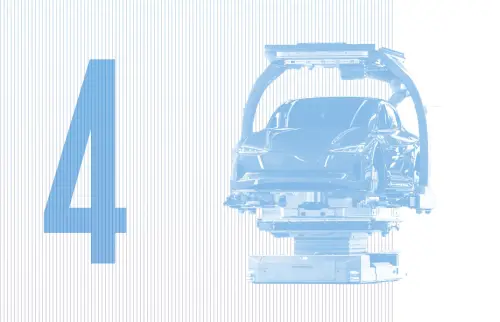This is a viewpoint from the USMCA Forward 2023 report where experts dive into the opportunities and complementary actions needed to build more integrated, resilient, and secure supply chains in North America.
 The automotive industry is undergoing a once-in-a-century technological transformation to electrification with significant implications for the North American auto supply chain. Automakers worldwide are committing an estimated $1.2 trillion to electrification globally through 2030 to build tens of millions of electric vehicles (EVs), more than double the amount from only one year ago.
The automotive industry is undergoing a once-in-a-century technological transformation to electrification with significant implications for the North American auto supply chain. Automakers worldwide are committing an estimated $1.2 trillion to electrification globally through 2030 to build tens of millions of electric vehicles (EVs), more than double the amount from only one year ago.
This transformation creates a generational opportunity to build an integrated and resilient North American EV supply chain underpinned by the United States-Mexico-Canada Agreement (USMCA). Given the importance of the auto industry to North America with annual production approaching 15 million vehicles in 2022, it is critical that Canada, Mexico, and the U.S. work together to ensure a smooth transition to electrification.
The automotive industry is competitive as part of the highly integrated North American market. The success of the industry has been enabled by the North American Free Trade Agreement (NAFTA) and now the USMCA that provides certainty and stability to the industry. Duty-free treatment given to originating vehicles and parts has enhanced supply chain integration and incentivized investments in North American production.
As a result of this integration, thousands of trucks and train cars ship vehicles, parts, and components across the continent every day as part of the assembly process. To make this happen, automotive companies operate complex logistical plans that ensure scheduled, uninterrupted delivery to and from the plants.
With the industry transitioning to electrification, a parallel supply chain is being created across North America from the mining of critical minerals to battery cell production and vehicle final assembly. According to the Centre for Automotive Research, automakers in the region announced $36 billion of investments in North America to build facilities dedicated to manufacturing EVs and batteries in 2021 and double the amount announced the same time last year for EV-related projects through the first half of 2022. The USMCA provides the certainty companies depend on to invest billions into this transformation in Canada, Mexico, and the U.S.; and the transformation is just getting started.
The scale of the opportunity facing North America is enormous. For example, the International Energy Agency (IEA) projects that for the world to achieve net zero globally by 2050, six times more mineral inputs will be required by 2040 than today. Of this increase, EVs and battery storage demand for mineral inputs are expected to grow by a least 30 times to 2040.
Fortunately for North America, Canada is in the top five countries producing cobalt, copper, graphite, precious metals, nickel, and uranium, and has the potential to expand in lithium, magnesium, and rare earths production. Canada is the only nation in the Western Hemisphere with deposits of the complete suite of minerals required to make next-generation electric batteries.
Increasing and diversifying Canadian production of critical minerals will enhance North American security and increase trilateral trade. Building North American supply chains from mineral exploration to production for these elements presents an important opportunity for job creation and economic growth, while ensuring responsible mining practices.
To achieve this, Canada’s recently released Critical Minerals Strategy aims to increase the supply of responsibly sourced critical minerals and support the development of domestic and global value chains for the green and digital economy. It includes $3.8 billion (CAD) in funding for a range of industrial activities, from geoscience and exploration to mineral processing, manufacturing, and recycling applications.
Combine this with the U.S. Inflation Reduction Act (IRA) and the blueprint for an integrated North American EV battery supply chain is beginning to take shape.
The IRA is arguably the most significant development for the North American auto industry since implementation of the USMCA. The U.S. is committing more than $370 billion to fight climate change, including massive new investments in EV manufacturing, sales, and infrastructure.
The IRA includes consumer EV incentives that are linked to sourcing EV battery components and critical minerals from North America or countries with which the U.S. is in trade agreements. It also unleashes a major new suite of incentives linked to manufacturing EVs and components inside America.
Fortunately for Canada, critical minerals and vehicles produced in Canada will be part of the EV supply chain the IRA establishes. But seizing the opportunity requires urgency. Here is how Canada should respond.
Priority one is ensuring our regulations and trade rules with the U.S. continue to be aligned so we are full participants in the transition to EVs.
Canada has reaped significant economic and social benefits by being part of an integrated auto sector in North America. Through common regulations and competitive supports, we manufacture and sell into a market accounting for annual sales of nearly 20 million vehicles. This remains an essential pillar of Canada’s manufacturing economy. It is this integration that has allowed automakers to announce historic investments in Canada to produce EVs.
Second, Canada must understand, identify, and react to the competitive gaps in our manufacturing sector that are exacerbated by the IRA. These competitive gaps are most obvious in clean energy manufacturing, where the act earmarks over $60 billion to support EV and battery manufacturing, among other technologies.
This means providing opportunities for companies that can be leveraged and compared against the IRA’s production tax credit for battery modules, cells, and electrode active materials. It also requires swift government action to deliver on the Critical Minerals Strategy and realize the supply chain opportunities stemming from critical mineral production.
Finally, the North American EV supply chain will not succeed without a greater effort to boost EV adoption. Canada needs a comprehensive plan to keep up with the U.S. on EV readiness. This means building accessible EV charging, ensuring a reliable national electric grid, and providing competitive purchase incentives to help drivers afford the switch to electric transportation.
Canada needs to keep pace with the U.S. in the transition to electrification to build an integrated and resilient North American supply chain.
The Brookings Institution is committed to quality, independence, and impact.
We are supported by a diverse array of funders. In line with our values and policies, each Brookings publication represents the sole views of its author(s).









Commentary
Building a North American electric vehicle supply chain
Tuesday, February 28, 2023